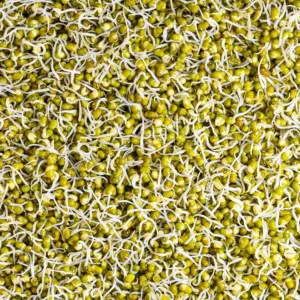
Pulses
Pulses are unique in that they produce most of their own nitrogen through rhizobium — a main reason why they’re commonly grown to help improve soil health. Inoculants can provide an added rhizobium boost for optimal growth, while nutrient use efficiency products can help ensure pulses are getting adequate levels of other key nutrients.
View Pulse ProductsWhat You Need to Know About Pulses
Top Pulse Products
View AllLegend
What Are the Vegetative Stages of Pulse Growth?
Different types of pulse crops include peas, lentils, chickpeas, dry beans and other legumes harvested for their dry seeds. The specific stages of pulse crop growth will depend, then, on the pulse variety. In general, pulse crops progress from seedling to primary branching or leaf growth stages to flowering, seed filling and maturity. Below is a table showing the typical vegetative states for pea, lentil, and chickpea crops.
Note that pulses are characterized by a long vegetative period as well as being photo and thermosensitive. The amount of growth during each crop stage is determined by the planting environment and levels of available nutrients among other factors. Knowing which stage of growth your pulse crops are in is essential for weed control and the health of the plants.
| Pea, Lentil, Chickpea | Data source: Stu Brandt, Scott, SK 1993-97 and Perry Miller, Swift Current, SK 1995-98 | Stage |
|---|---|---|
| Leaf Stages | Two leaves unfolded. Four leaves unfolded. Six leaves unfolded. Eight leaves unfolded. |
1.2 1.4 1.6 1.8 |
| Folwering | Flowering begins. At least one open floret on 50% or more plants. Flowering 50% complete. |
6.0 6.5 |
| Seed fill | Seed fill begins. 10% of seeds have reached final size | 7.1 |
| Maturity | Seed begins to mature. 10% of seed has changed color. | 8.1 |
| Maturity complete | 90% of seed changed color. Await completion of drydown for direct harvesting. | 8.9 |
Citation: https://apps.msuextension.org/montguide/guide.html?sku=MT200103AG
Nitrogen Fixation in Pulse Crops
Nitrogen fixation in pulse crops involves the assimilation of nitrogen into organic compounds. For nitrogen fixation to occur in pulse crops, there must be a high enough concentration of Rhizobium bacteria in the soil, specific to different types of pulses. How this works is that Rhizobium bacteria in root nodules fix nitrogen gas from the air and soil by binding it with hydrogen, making the nitrogen available to the plants.
What are Tips for Planting Pulse Crops?
There are a few things to keep in mind when it comes to planting and cultivating pulse crops. Pulses grow best in cool, arid climates with limited rainfall. Plant them earlier in the year to reduce the risk of heat damage that can happen at temperatures higher than 82 degrees Fahrenheit. Often, March will be a good time to plant pulses.
Plant pulse crop seeds one-half inch below the soil’s moisture line at a max depth of three inches, allowing the seeds to get the necessary amount of moisture to germinate. Germination begins when the soil temperature is 38 degrees Fahrenheit, with emergence following in about three weeks. Day length, air temperature, genetic variation, and soil bacteria concentrations all influence the growth rate of pulses and progression through reproductive and vegetative stages.
Lastly, don’t forget to watch out for pests, insects, and diseases that can negatively impact yields and pulse production. Fungicide application can help with weed control and soil insecticides can keep away pests such as grasshoppers, wireworms and other insects.
Are Inoculants Necessary for Pulse Production?
Pulse crop inoculants are necessary for the plants to get sufficient Rhizobium bacteria needed for nitrogen fixation. Without sufficient Rhizobium bacteria in the soil, nodulation won’t be as successful and yields will be lower. Inoculation of pulses is done either by treating the soil with liquid or dry inoculants or by directly applying a liquid or powder-based inoculant to the seed. When applied correctly, pulse plants will receive the necessary bacteria for nitrogen fixation. Double inoculation using liquid, powder or granular products can produce higher yields. Keep in mind that different types of pulse crops require different types of Rhizobium species for nodulation.
How Do You Monitor Pulse Crop Nodulation?
There are certain signs to look for when tracking pulse crop growth and development through vegetative stages. Formation of nodules typically takes two to four weeks for pulse crops, depending on growing conditions, pulse nutrition, and rate of nitrogen fixation. To monitor nodulation, carefully dig up pulse plants from different areas of the field. Brush off the dirt from the roots in order to look for nodules, which appear in clumps along the primary and/or secondary roots.
To check for successful fixation in nodules, cut them open and look closely at the interior color. Active nitrogen fixation is indicated by a pink or red color caused by the iron-containing substance called leg-hemoglobin, which is necessary for fixation. If the inside of your pulse crop nodule is white, green or brown, then fixation isn’t active. Poor nitrogen fixation also leads to yellowed leaves toward the base of the plant prior to flowering. Conversely, pulse crops with nodules greater in size and number is a clear sign of successful nitrogen fixation.
Key Considerations for Pulse Crops
Nutrient Management
Pulses are commonly used as a rotation crop to improve soil health, since they produce most of their own nitrogen through rhizobium. Inoculants can improve nitrogen creation, but be sure to ensure that the proper inoculant is used for the crop grown.
Soil & Temperature Requirements
Pulses can be grown in a wide range of soils, from sandy to heavy black soils. While the ideal soil is typically well-drained loam, it does vary between different types of pulse crops. Pulses do well in soils with lots of microorganisms and require a pH at or near 6.7 for optimal growth and nutrient availability. Additionally, they utilize moisture very efficiently, and are tolerant to moderate drought stress.
Pest Management
Fortunately, pulses are fairly tolerant to insect and pest damage, but insecticides can be used if insect populations are particularly high. If your pulses are experiencing disease pressure, fungicide along with an integrated pest management plan is key.
Key Nutrients
Nitrogen
N fixation can be an issue if there are high residual N levels in the soil
Phosphorus
Proper phosphorus levels are essential for plant development and can help ensure N fixation.
Micronutrients
Pulses are good at absorbing the micronutrients they need from the soil.
Products for Pulses
Legend
Ferrous (Iron) Sulfate




















